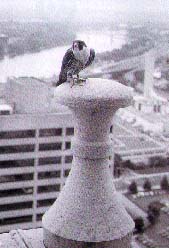|
________________
CM . . . .
Volume VII Number 16 . . . . April 13, 2001
excerpt: DDT prevents a nutrient called "calcium" from being used in the making of eggshells. So, while the mother is producing the eggs, calcium is not getting into the shells. Since the eggshells lack calcium, they are weak and crumble easily. Therefore, when the mother sits on the eggs to keep them warm, she often crushes them. If the eggs are crushed before the chicks hatch, there will be no new peregrine falcons. This is what was happening to the peregrine falcons in North America.  Thanks to a 30-year recovery effort on the part of the government, scientists and concerned
citizens, the peregrine falcon is no longer on the endangered species list. This book focuses on the
reason for the decline in the falcon population - DDT- and explains, in a way that is easy to
understand, how DDT works. The life cycle, habitat, hunting methods and the physical and
behavioral adaptations of peregrines are also discussed. Both the American and the Canadian
governments' action plan for the recovery of peregrine falcon numbers are outlined. Several goals
ensured the plan's success: North America was divided into five regions, each with its own
population goal; mating pairs were to reach a goal for raising their offspring; DDT levels had to
decrease significantly; and eggshells had to return to a more normal thickness. The remainder of
the book explains the steps that were taken in order to achieve these goals.
Thanks to a 30-year recovery effort on the part of the government, scientists and concerned
citizens, the peregrine falcon is no longer on the endangered species list. This book focuses on the
reason for the decline in the falcon population - DDT- and explains, in a way that is easy to
understand, how DDT works. The life cycle, habitat, hunting methods and the physical and
behavioral adaptations of peregrines are also discussed. Both the American and the Canadian
governments' action plan for the recovery of peregrine falcon numbers are outlined. Several goals
ensured the plan's success: North America was divided into five regions, each with its own
population goal; mating pairs were to reach a goal for raising their offspring; DDT levels had to
decrease significantly; and eggshells had to return to a more normal thickness. The remainder of
the book explains the steps that were taken in order to achieve these goals.
Text is large and easy to read, though the vocabulary is somewhat inconsistent in its difficulty. A glossary and a brief list of addresses and websites for wildlife protection agencies are included. Tables, maps and colour photographs enhance the text. One minor flaw: though the author writes about the recovery efforts both of the Canadian and American governments, only the map of the United States is shown. In addition to the basic information about falcons and the action plan designed to save them, the underlying message of perseverance and the strength of many people working together for a common cause will strike a chord with youngsters. And, in keeping with the environmental theme, a portion of the price of the book will be donated to saving endangered animals. Recommended. Gail Hamilton is a teacher-librarian at Bird's Hill School in East St. Paul, MB.
To comment on this title or this review, send mail to cm@umanitoba.ca.
Copyright © the Manitoba Library Association.
Reproduction for personal use is permitted only if this copyright notice
is maintained. Any other reproduction is prohibited without
permission.
Published by
TABLE OF CONTENTS FOR THIS ISSUE - April 13, 2001.
AUTHORS |
TITLES |
MEDIA REVIEWS |
PROFILES |
BACK ISSUES |
SEARCH |
ORDER |
CMARCHIVE |
HOME
|
